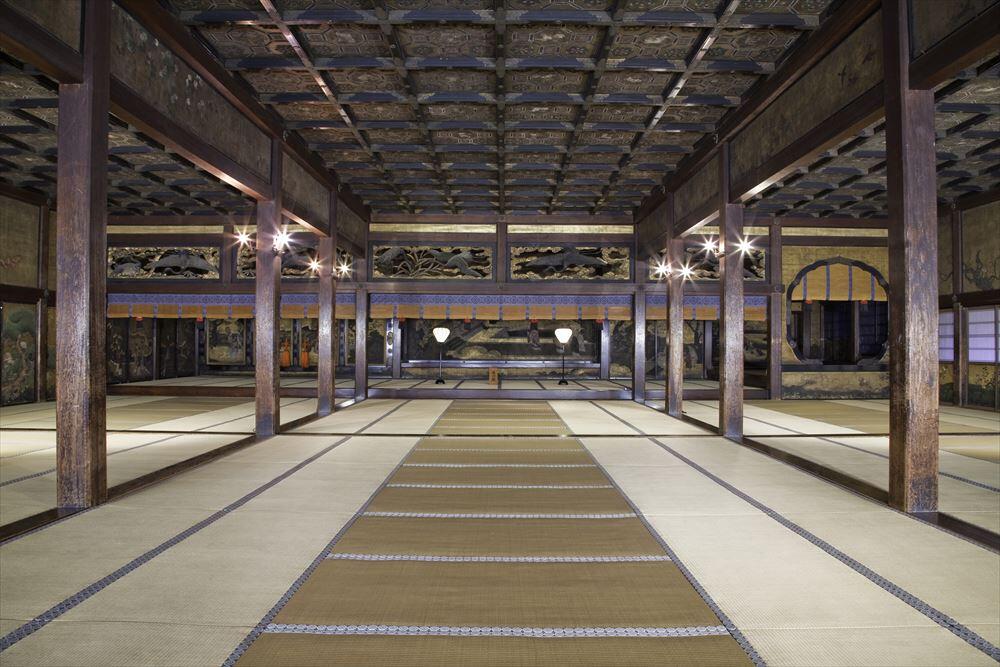音声ガイド_11_対面所
11.対面所(Main Audience Hall)

日本語
この部屋は「対面所(たいめんしょ)」といい、200畳あまりの大広間です。正面欄間に雲の中を飛ぶ、鴻の鳥が彫刻されていることから、別名、「鴻之間」とも呼ばれています。 正面、上段の間の壁画は「商山四皓(しょうざんしこう)の図」といいます。中国・漢の時代に政治に関与することを嫌って、隠遁生活をしていた四人の賢者を、張良という知恵者がうまく説得し、当時の皇帝、恵帝(えてい)に面会するところが描かれています。 この絵の描き方は、私達が日頃みる遠近の感覚とは大分(だいぶん)異なっています。ふつうは遠方を小さく描きますが、この絵ではむしろ遠い方が大きめに描いてあります。この画法を逆遠近法といい、その絵の前に座った人を浮き立たせるため、この手法を用いたといわれております。 また、正面上段の間の向かって左側、赤い房の下がった襖を帳台構(ちょうだいがまえ)といい、その後ろの部屋は「武者隠しの間」と申します。続いて向かって左手に描かれた大きな老松(おいまつ)と鶴の絵は、襖に描かれた一本松の絵では日本で最大級といわれております。描かれている絵具は鉱物性(こうぶつせい)のものなどを用い、緑色は銅のサビ、茶色は鉄のサビ、赤色はサンゴ、白色は白金(はっきん)、そのほか水晶などが使われております。
中文
11 對面所 這個房間被稱為"對面所",是一間鋪有200多張榻榻米的大房間。因為在正面的楣窗上雕刻著雲中飛翔的鴻鵠,因此這一部分被稱為"鴻之間"。 "上段之間"的壁畫叫做《商山四皓圖》。畫中描繪了中國漢朝時期,因為厭惡政治而過著隱居生活的四位賢者,在足智多謀的張良的勸化之下謁見了孝惠帝的故事。 在表現遠近的繪畫手法上與正常地表現方式有所不同。一般是把表現遠的物體畫得小一些,而這幅畫則正相反。這種畫法叫做"逆遠近法",據說這是為了突出坐在中央的人的威武與莊嚴。 在面向"上段之間"的左側,有兩扇掛著硃紅色流蘇的門,叫做"帳台備",後面還有一個隱藏武士的房間。再往左的拉門兒上畫著巨大的《金碧松鶴圖》,這棵松樹被稱為日本最大的松樹繪畫作品。繪畫材料大部分採用的是礦石。綠色採用的是銅鏽、茶色採用的是鐵鏽、紅色採用的是珊瑚、而白色則採用了白金來表現。另外還採用了水晶等材料來裝飾。
한국어
11 대면소 이 방은 대면소라는 이름으로 다다미로 된 약 100평의 대형급 방입니다. 정면 교창에 구름 속을 나는 대형 백조가 조각되어 있어 별칭 '고오노마'라고도 불립니다. 정면 상단 방의 벽화는 '쇼잔 시코'의 그림'이라고 합니다. 중국 한나라 때 정치에 관여하기를 꺼려 은둔생활을 하던 4명의 현자를 장량이라는 지혜로운 사람이 잘 설득하여 당시 황제인 혜제와 알현시키는 장면이 그려져 있습니다. 이 그림의 기법은 원근법인데 우리들이 평소 접하는 원근 감각과는 많은 차이를 보입니다. 보통은 먼 곳을 작게 그리지만 이 그림은 오히려 먼 쪽을 크게 그렸습니다. 이 화법을 역원근법이라고 합니다. 이 그림 앞에 앉은 사람을 부각시키기 위해 이 수법을 사용했다고 합니다. 또한, 정면 상단 방과 마주해서 있는 왼편의 빨간 술장식이 달린 맹장지를 '초다이가마에'라고 하며 그 뒷편 방은 '부샤가쿠시노마'라고 합니다. 이어서 맞은켠 왼편에 는 큰 노송나무와 학 그림이 그려져 있는데 맹장지에 그려진 한그루의 소나무 그림으로는 일본 최대급이라고 합니다. 그림 물감은 광물성 재질을 사용하였는데 초록색은 동의 녹, 갈색은 철의 녹, 빨간색은 산호, 흰색은 백금, 그밖에 수정 등도 사용되었습니다.
English
11 Main Audience Hall Largest among the Shoin Chambers, the Main Audience Hall or Taimensho, is also referred to as the Chamber of Storks for the carvings in the transom above the raised central alcove. On the back wall of the alcove, is a painting known as The Four Sages of Mount Shang. Wanting to flee from the politics and turbulent society of the Qin (Shin) Dynasty, the four sages lived in seclusion on Mount Shang while engaging in scholarly pursuits. Later during the Han Dynasty, Chang Liang (Jpn. Chou Ryou) an Imperial officer, was sent to invite the four men back to the Imperial Court. After much convincing and debate, the four men retired back to the Imperial court to support crown prince Huidi. The mural is a scene of the four sages coming to pay their respects to the new emperor. When a person is in front of the painting, the person gives the appearance of being larger than he actually is. This illusion is created by a technique known as reverse-perspective in which images in the distance that are normally drawn smaller are actually drawn larger. Facing the alcove, the sliding tasseled doors to the left is referred to as choudaigamae, where behind it is a guardroom. Continuing on to the left panels of the Main Audience Hall is the painting of a giant pine and cranes. The giant pine is said to be one of the largest of its kind in Japan. Like the cranes that are painted using white oyster shells, the paintings are painted with colors of pulverized natural rocks and minerals such as copper rust for green, rust for brown, red hues from coral, white using minerals such as white gold, and quartz to name a few. Unlike the paints that are commonly used today, this is why the paintings have remained for so long.
Português
11 Taimensho (Salão Principal de Audiência) O Hongwanji possui dois palcos ao ar livre para o Teatro Clássico Nô que é apresentado com máscaras. O Palco Sul localiza-se à frente do Salão Principal de Audiência. As apresentações de teatro Nô são realizadas anualmente neste lugar no dia vinte e um de maio, na Celebração do Aniversário do Fundador, Shinran Shonin. O teatro Nô é usado tradicionalmente pelo Hongwanji e foi popularizado por Rennyo Shonin no século quinze.


